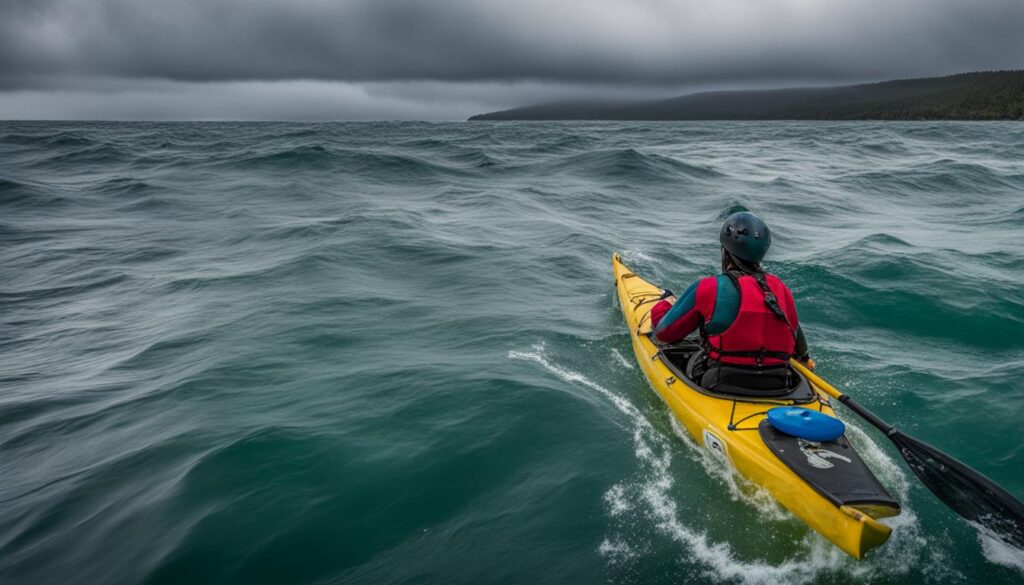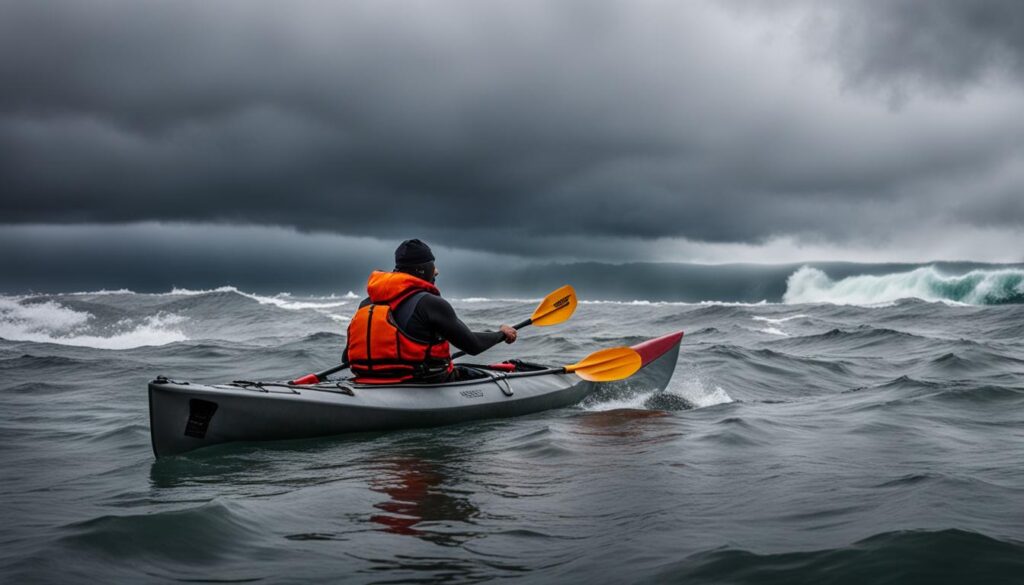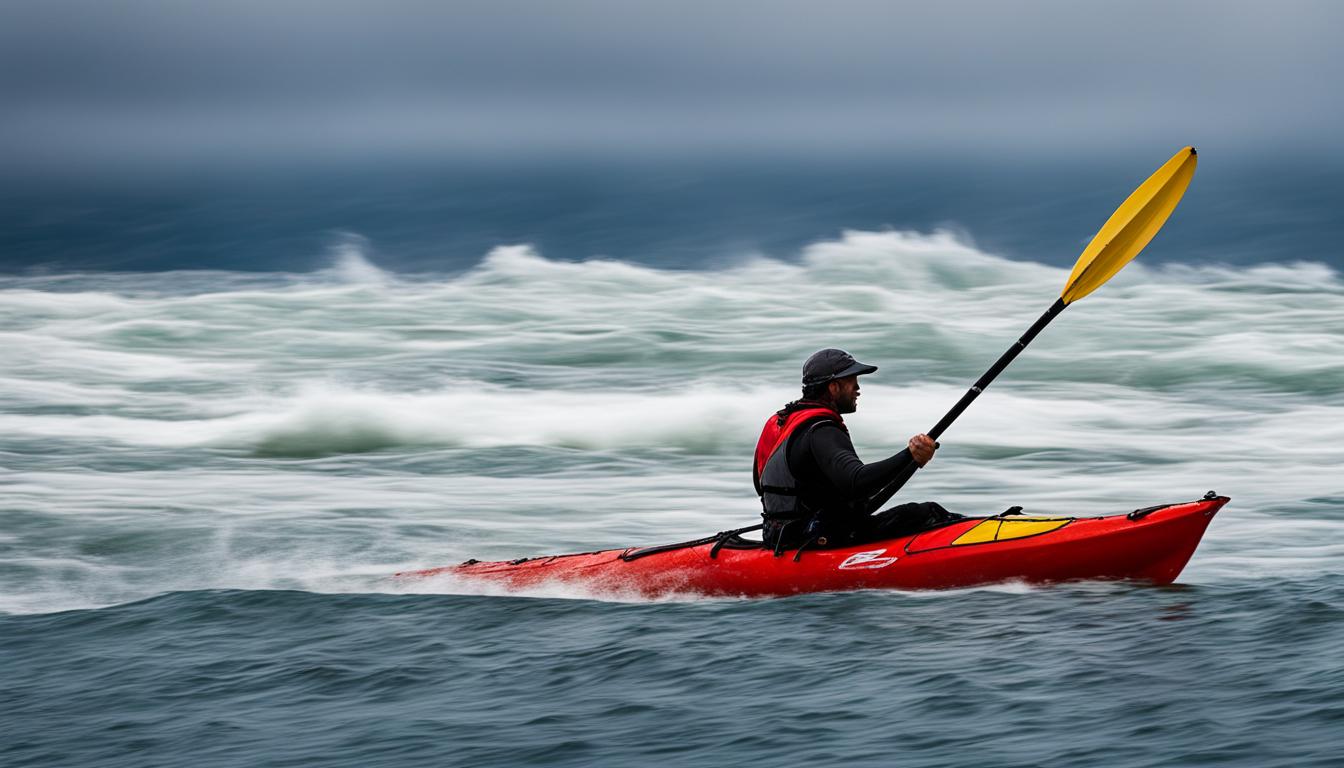Managing sea sickness while kayaking can greatly enhance your paddling experience. The constant motion of the waves can trigger symptoms such as dizziness, nausea, and fatigue, making it difficult to fully enjoy your time on the water. However, with the right strategies and remedies, you can prevent and manage seasickness, allowing you to fully embrace the thrill of kayaking.
Key Takeaways:
- Prevent motion sickness while kayaking by avoiding overeating and excessive water intake before paddling.
- Expand your visual range beyond the immediate surroundings of your kayak to mentally adjust to the constant motion of the waves.
- Consider natural remedies such as chewing gum, ginger, or acupressure wrist bands for relief.
- In severe cases, perform a contact tow or rafted tow to bring you safely to shore if seasickness affects your ability to paddle.
- By gradually acclimating yourself to longer periods in choppy waters, you may reduce the likelihood of seasickness.
Understanding the Causes and Symptoms of Seasickness
Seasickness is a common condition experienced by many kayakers, often caused by conflicting signals between the inner ear and the eyes. When the signals from the inner ear, responsible for balance and motion detection, do not match the visual cues perceived by the eyes, it can lead to symptoms such as dizziness, vertigo, nausea, and fatigue.
The perception of stability and the expectation of a stationary environment can contribute to motion sickness in kayakers. The constant motion of the waves in open-water kayaking makes individuals more susceptible to seasickness. It is essential to understand the causes and symptoms to effectively prevent and manage this condition.
The primary cause of seasickness is the mismatch of information between the inner ear and visual cues. Conflicting visual cues, such as seeing the movement of the water while seated in a kayak, can confuse the brain and trigger symptoms. Additionally, factors such as anxiety, stress, and a history of motion sickness can increase susceptibility. Recognizing the signs of seasickness, including dizziness, nausea, pale skin, sweating, and headache, can help kayakers take appropriate action to alleviate these symptoms.
The Causes of Seasickness:
- Conflicting signals between the inner ear and the eyes
- Perception of stability and expectation of a stationary environment
- Anxiety, stress, and history of motion sickness
Common Symptoms of Seasickness:
- Dizziness
- Vertigo
- Nausea
- Fatigue
Table: Causes and Symptoms of Seasickness
| Causes | Symptoms |
|---|---|
| Conflicting signals between the inner ear and the eyes | Dizziness |
| Perception of stability and expectation of a stationary environment | Vertigo |
| Anxiety, stress, and history of motion sickness | Nausea |
| Fatigue |
Prevention Techniques for Managing Seasickness
When it comes to preventing seasickness while kayaking, there are several effective strategies you can employ. By avoiding triggers, expanding your visual range, and mentally disconnecting from the constant motion, you can minimize the chances of experiencing motion sickness.
One key avoidance tactic is to refrain from overeating and excessive water intake before your kayaking trip. These can contribute to feelings of nausea and discomfort while on the water. Similarly, it’s best to abstain from alcohol consumption, as it can further disrupt your body’s equilibrium and increase the likelihood of seasickness.
| Prevention Techniques | Benefits |
|---|---|
| Expand your visual range | By focusing on objects in the distance, such as the horizon or shoreline, you can provide your brain with a stable visual reference point, minimizing the conflicting signals between your inner ear and eyes. |
| Mentally adjust to the motion | By acknowledging and accepting the constant motion of the waves, you can better prepare your mind for the sensations experienced while kayaking, reducing the likelihood of feeling dizzy or nauseous. |
| Natural remedies | Chewing gum, ginger, and acupressure wrist bands can provide relief for some individuals. These remedies have been known to alleviate symptoms of motion sickness. |
| Medications | Certain medications like Dramamine or Scopolamine pills can be effective in preventing seasickness. However, it’s important to consult with a healthcare professional before taking any medication. |
By implementing these prevention techniques, you can significantly reduce the chances of experiencing seasickness during your kayaking adventures. Remember to listen to your body, take breaks when necessary, and always prioritize your safety and well-being on the water.
Coping with Seasickness on the Water
When seasickness strikes while you’re out on the water, it’s important to take immediate action and implement coping strategies. Here are some tips to help you manage seasickness effectively:
1. Communicate with your paddling group
If you start experiencing seasickness symptoms, it’s crucial to let your fellow paddlers know about your condition. This will ensure that they are aware and can provide any necessary assistance or support. Open and clear communication is key to ensuring everyone’s safety and well-being during kayaking trips.
2. Take preventive measures
While it’s ideal to prevent seasickness before it occurs, there are still steps you can take while on the water. Resting and staying hydrated can help alleviate symptoms. Drinking ginger tea or consuming light, starchy snacks like crackers can also help ease nausea. These preventive measures can make a difference in managing your seasickness and allowing you to continue enjoying your kayaking adventure.
3. Utilize kayak rescue techniques
If your seasickness becomes severe and affects your ability to paddle or maintain balance, it may be necessary to employ kayak rescue techniques. A contact tow or rafted tow can be used to safely bring you back to shore. These techniques involve another paddler assisting you by either towing your kayak or paddling alongside you to provide stability. Familiarity with these techniques is crucial for both experienced kayakers and beginners.

4. Seek professional help if needed
If your seasickness persists or worsens, it may be necessary to seek professional medical advice. A healthcare professional can offer guidance on specific medications or treatments that may help manage your seasickness more effectively. It’s always important to prioritize your health and well-being above all else.
By implementing these coping strategies, you can navigate the challenges of seasickness while kayaking and continue to enjoy your outdoor adventures with confidence and peace of mind.
Personal Strategies for Overcoming Seasickness
Dealing with seasickness can be a personal journey, as each individual may have their own methods for managing this condition based on their unique experiences. Overcoming motion sickness while kayaking requires trial and error to find what works best for you. Some kayakers have found success through gradual acclimation, gradually increasing their exposure to choppy waters. By gradually building tolerance, you can train yourself not to get seasick as easily. Others have found relief through specific medications, natural remedies, or alternative therapies such as acupuncture wrist bands.
Participating in kayak camping trips can provide a valuable opportunity to overcome seasickness through exposure and adaptation. By spending extended periods on the water and engaging in longer paddling adventures, you can gradually familiarize yourself with the constant motion of the waves. This exposure can help desensitize your body and reduce the likelihood of experiencing seasickness. Additionally, exploring different environments and challenging yourself with varying conditions can further aid in overcoming motion sickness.
Personal experiences and perseverance play a significant role in managing seasickness. It’s important to remember that it’s a journey, and what works for one person may not work for another. Don’t be discouraged if your first attempt at managing seasickness is not successful. Keep trying different strategies, seeking advice from experienced kayakers, and learning from your own experiences until you find what works best for you.
Table: Comparison of Personal Strategies for Overcoming Seasickness
| Strategy | Advantages | Disadvantages |
|---|---|---|
| Gradual acclimation | – Helps build tolerance – Allows for gradual adaptation |
– Requires time and patience – May not work for everyone |
| Medications | – Provides immediate relief – Convenient and accessible |
– May have side effects – Requires consultation with a healthcare professional |
| Natural remedies | – Potentially fewer side effects – Can be easily accessible |
– Effectiveness varies among individuals – May require experimentation |
| Alternative therapies | – Provides alternative options – May have additional benefits |
– Limited scientific evidence – Results can vary |
Remember, managing seasickness is a personal journey, and what works for one person may not work for another. It’s essential to approach it with an open mind, be patient with yourself, and embrace the process of finding your own strategies for overcoming motion sickness. With time, experience, and the right techniques, you can train yourself to adapt and conquer seasickness, making your kayaking trips more enjoyable and fulfilling.

Recognizing the Signs and Symptoms of Seasickness
Seasickness can be an unpleasant experience for kayakers, but it is important to understand and recognize the signs and symptoms. By familiarizing yourself with the indicators of seasickness, you can take appropriate action to address the issue. Here are some common signs to look out for:
- Dizziness: Feeling unsteady or lightheaded
- Nausea: Sensation of queasiness or an upset stomach
- Pale Skin: A noticeable change in complexion
- Sweating: Experiencing perspiration, even if the weather is cool
- Headache: Feeling discomfort or pain in the head region
It is important to note that these symptoms can vary in severity and may not occur all at once. However, if you experience a combination of these signs during or after kayaking, it is likely that you are dealing with seasickness. It is crucial to differentiate seasickness from other conditions that may present similar symptoms, such as dehydration, fatigue, or more severe medical issues. If you are unsure about the cause of your symptoms or if they persist, it is recommended to consult a healthcare professional for a proper diagnosis.
| Condition | Symptoms | Appropriate Action |
|---|---|---|
| Seasickness | Dizziness, nausea, pale skin, sweating, headache | Rest, hydrate, and take preventative measures for future trips |
| Dehydration | Thirst, dry mouth, dark urine, fatigue | Drink plenty of water and rehydrate your body |
| Fatigue | Weakness, exhaustion, difficulty concentrating | Get adequate rest and ensure proper nutrition |
| Medical Issues | Palpitations, difficulty swallowing, weakness in one arm or leg, decreased vision | Seek immediate medical attention |
By understanding the signs of seasickness and being able to differentiate them from other conditions, you can respond appropriately and make informed decisions about your health and well-being while kayaking.
Treatment and Prevention of Seasickness
When experiencing seasickness while kayaking, there are various treatment options available to alleviate symptoms. One effective method is to focus your vision on a stationary object in the distance, such as the horizon or shoreline. This can help reduce dizziness and provide a visual reference point to counteract the motion of the water. Additionally, splashing water on your face and staying hydrated by sipping sports drinks can provide temporary relief from nausea and fatigue.
If seasickness becomes severe and the symptoms impact your ability to paddle or maintain balance, it may be necessary to consider medications to prevent or manage the condition. Over-the-counter options like Dramamine or Bonine can be effective when taken prior to experiencing motion. These medications work by suppressing the signals from the inner ear that contribute to motion sickness. It is important to follow the recommended dosage and consult with a healthcare professional if you have any underlying medical conditions or take other medications.
“I found that focusing on a fixed point on the horizon helped alleviate my seasickness while kayaking. It gave me a sense of stability amidst the motion of the waves.”
Comparing Medication Options for Seasickness
| Medication | Dosage | Effectiveness | Common Side Effects |
|---|---|---|---|
| Dramamine | 1-2 tablets every 4-6 hours | Effective in preventing and treating mild to moderate seasickness | Drowsiness, dry mouth, blurred vision |
| Bonine | 1 tablet every 24 hours | Long-lasting relief from seasickness for up to 24 hours | Drowsiness, dry mouth, constipation |
It is important to note that while medication can be helpful in managing seasickness, it is not a cure. The only sure way to stop seasickness is to remove yourself from the motion of the water or wait for the symptoms to subside naturally. Therefore, it is essential to take preventative measures by staying hydrated, avoiding alcohol before paddling, and properly preparing yourself for the conditions you’ll encounter on the water.
By utilizing the available treatment options and taking proactive steps to prevent seasickness, kayakers can enhance their overall experience on the water and enjoy their paddling adventures with greater comfort and confidence.
Coping with Seasickness: Tips for Enjoyable Kayaking Trips
Seasickness can be a challenge for kayakers, but with the right strategies, you can manage and overcome this condition, ensuring enjoyable kayaking experiences. Proper preparation is key to preventing motion sickness during your trips. Take the time to acclimate yourself to longer periods spent in choppy waters. Gradually exposing yourself to these conditions can help reduce the likelihood of seasickness.
Additionally, consider utilizing medications or natural remedies that have been effective for others. Some kayakers find relief with over-the-counter options like Dramamine or Bonine, while others swear by the benefits of ginger or acupressure wrist bands. Finding what works best for you may require some experimentation, so don’t hesitate to try different methods.
Remember, you don’t have to face seasickness alone. Seek support from your paddling companions. They can provide encouragement, distractions, or even practical assistance if needed. Sharing your experiences and tips with fellow kayakers can also create a sense of camaraderie and make your kayaking trips even more enjoyable.
FAQ
What causes seasickness?
Seasickness is caused by conflicting signals between the inner ear responsible for balance and motion detection, and the visual cues perceived by the eyes.
What are the symptoms of seasickness?
Symptoms of seasickness include dizziness, vertigo, nausea, and fatigue.
How can I prevent seasickness while kayaking?
To prevent seasickness, avoid overeating and excessive water intake before paddling, abstain from alcohol consumption, expand your visual range beyond the immediate surroundings, and consider natural remedies or medication.
What should I do if I get seasick while kayaking?
If seasickness occurs, communicate with your paddling group, rest, stay hydrated, consume light, starchy snacks, and consider performing a contact tow or rafted tow to bring you safely to shore.
Are there any personal strategies for overcoming seasickness?
Yes, some kayakers find that gradually acclimating themselves to longer periods in choppy waters or trying alternative therapies can help reduce seasickness.
How can I differentiate seasickness from more serious conditions?
While seasickness shares some symptoms with other conditions, additional symptoms such as palpitations, difficulty swallowing, weakness in one arm or leg, or decreased vision should be evaluated by a medical professional.
What treatments are available for seasickness?
Treatment options include focusing on a stationary object in the distance, splashing water on your face, sipping sports drinks, and using over-the-counter medications like Dramamine or Bonine.
How can I make kayaking trips enjoyable despite seasickness?
By adopting prevention strategies, recognizing the signs of seasickness, and employing coping techniques, you can still have enjoyable kayaking experiences.





